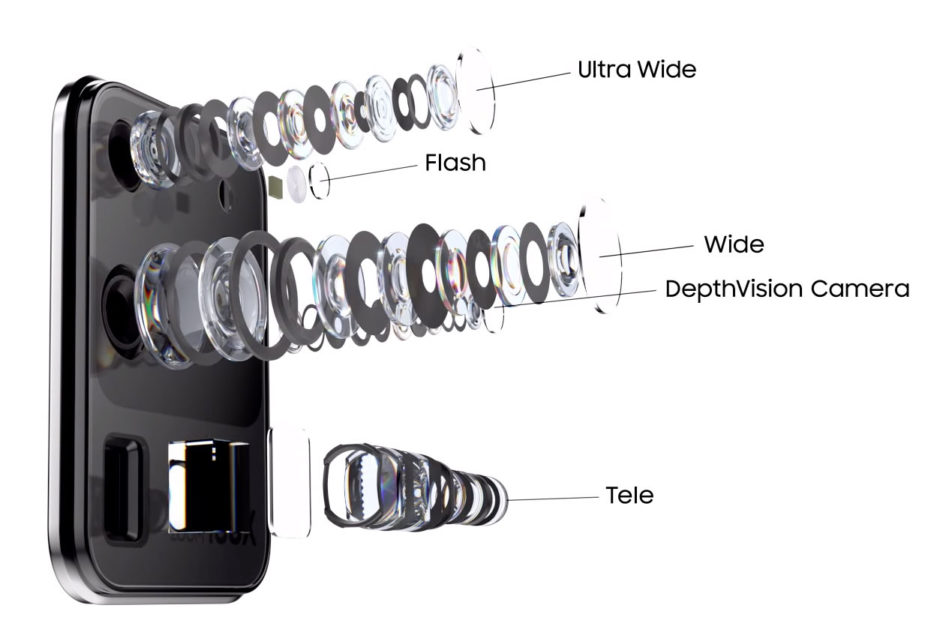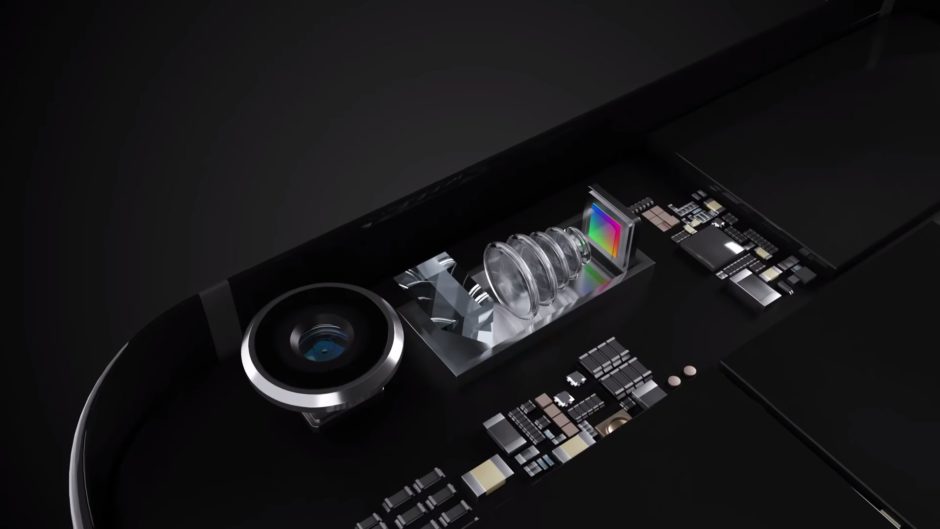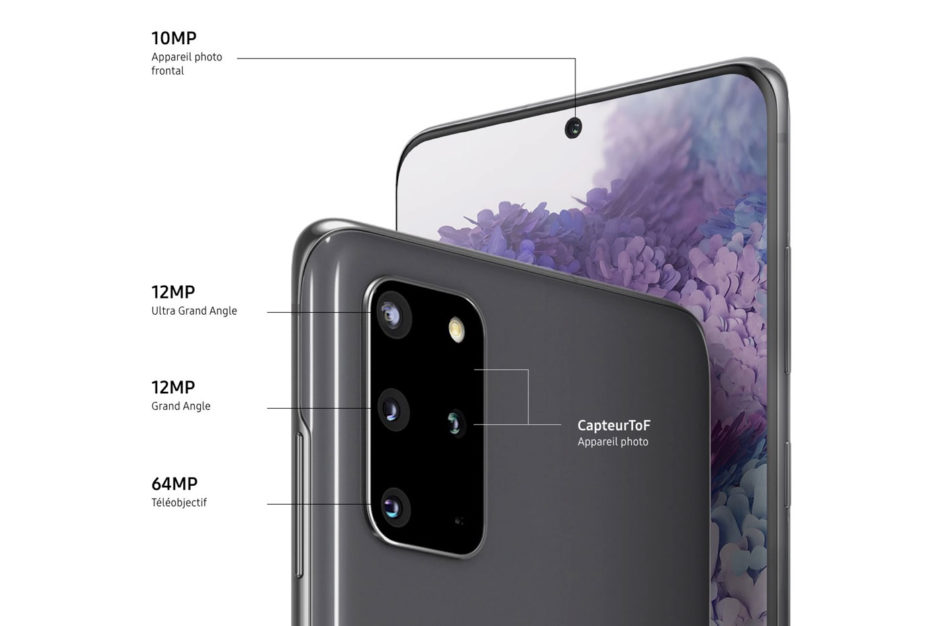After several months of suspense and rumors of all kinds, the Korean manufacturer has just formalized the Samsung Galaxy S20, S20 + and S20 Ultra . All three are already available for pre-order - at a more than high price. All three have a technical sheet particularly provided in the photo , which we invite you to return to in this article.

Galaxy S20, S20 + and S20 Ultra: three new high-end smartphones
On the sidelines of the Mobile World Congress - canceled this year because of the Coronavirus - Samsung unveiled its new generation of smartphones during a mass called Galaxy S20 Unpacked .
A year after the Galaxy S10, S10 Plus and S10e (and six months after Galaxy Note 10 and Note 10+ ), Samsung is back on the scene… and is taking the opportunity to change the nomenclature of its high-end smartphones. Here, no Galaxy S11 but Galaxy S20 : a way for Samsung to mark the change of decade .

In terms of design, these three new models immediately stand out with their giant 6.2, 6.7 and 6.9 inch screens covering almost the entire front . In the middle of the upper part, a tiny punch allows to shelter the central camera. Note also the refresh rate of these displays, which goes from 60 Hz to 120 Hz for greater fluidity of the animations and transitions between the screens.
At the back, Samsung equips its trio with a glass surface - which admirably retains fingerprints. But we will especially notice the imposing rectangle housing the different photo modules , which we will come back to below.

In addition, these three Samsung models incorporate high-end (very) components : latest generation Exynos 990 processor (for Europe) coupled with 8 or 12 GB of RAM (or even 16 on the Ultra version), up to 512 GB of storage , a battery of 4000, 4500 or even 5000 mAh , a specific version offering compatibility with (future) 5G networks…
Undoubtedly, the Galaxy S20, S20 + and S20 Ultra put the small dishes in the large to seduce the consumers - and to consolidate the position of Samsung as n ° 1 in the very competitive market of smartphones.

The Samsung Galaxy S20 alongside its big brother the S20 +
Photo side: the pixel race relaunched by Samsung
It's no mystery to anyone: for several years, the photo has become one of the main differentiating assets for smartphone manufacturers. While photo news has been mainly occupied in recent months by models from Apple, Huawei or Google, Samsung is back in force with sensors of 12, 64 and even 108 million pixels .
However, the three Samsung models do not integrate the same back-end photo module . To see more clearly, please refer to the comparison table below.
| S20 | S20 + | S20 Ultra | |
|---|---|---|---|
| Big angle | 12 MP, 26 mm, f / 1.8 | 12 MP, 26 mm, f / 1.8 | 108MP, 26mm, f / 1.8 |
| Ultra wide angle | 12 MP, 13 mm, f / 2.2 | 12 MP, 13 mm, f / 2.2 | 12 MP, 13 mm, f / 2.2 |
| Telephoto zoom | 64 MP, 27 mm, f / 2.0 | 64 MP, 27 mm, f / 2.0 | 48 MP, 102 mm, f / 3.5 |
| "Hybrid" zoom | 3x | 3x | 10x |
| Super Res Zoom | 30x | 30x | 100x |
| ToF sensor | No | Yes | Yes |
| Video | 8K at 24 fps, 4K at 60 fps, 1080p at 240 fps, 720p at 960 fps | 8K at 24 fps, 4K at 60 fps, 1080p at 240 fps, 720p at 960 fps | 8K at 24 fps, 4K at 60 fps, 1080p at 240 fps, 720p at 960 fps |
| Front camera | 10MP, 80˚, F2.2 | 10MP, 80˚, F2.2 | 10MP, 80˚, F2.2 |
Samsung Galaxy S20 Ultra: 108 MP, periscopic zoom and Space Zoom
Once is not custom, let's stop first on the characteristics of the largest model of this trio. This new Galaxy S20 Ultra incorporates a photo module of all superlatives. We thus find:
- A main 108 Mpx sensor measuring 1 / 1.33 '' - with 0.8 µm photosites and phase detection autofocus - fitted with a standard 26 mm stabilized lens opening at f / 1.8
- A secondary 12 MP sensor surmounted by an ultra wide-angle equivalent 13 mm opening at f / 2.2 and optical and electronic stabilization (Super Steady Video)
- A third 48 Mpx 1/2 '' sensor - with phase detection autofocus - equipped with a stabilized “periscopic” zoom equivalent 102 mm and opening at f / 3.6.

Samsung Galaxy S20 Ultra photo module
This main 108MP sensor is not unknown to us. Last September, Samsung formalized its ISOCELL Bright HMX , designed in partnership with the Chinese Xiaomi. The S20 Ultra thus becomes the second smartphone to benefit from this ultra-defined sensor , shortly after the Xiaomi Mi Note 10 . In practice, the S20 Ultra captures 12 MP images using what Samsung has poetically called " nona binning " - which consists of grouping nine pixels into one to reduce digital noise, increase the amount of detail in images and capture a larger amount of light.
Beyond the secondary 12 MP sensor dedicated to the ultra wide-angle , we will focus especially on the "periscopic" x4 x 102 mm equivalent zoom - which is one of the main arguments of this new model.

To accommodate such an impressive optical zoom, Samsung has “borrowed” the technique used by the Huawei P30 Pro , released a year ago. Thus, the lenses are mounted perpendicular to the back of the device . The light hits a prism and the camera plays on the position of the lenses to adjust the zoom level. Thus ready, the S20 Ultra must be able to easily capture the most distant subjects. To explain how it works, Samsung had also published an explanatory video in September 2019:
To see further, Samsung also offers a "hybrid" x10 zoom , which is based on the use of pixel binning and uses a congruent portion of the main sensor of 108 MP. But the Korean manufacturer also introduces a new feature, called Space Zoom , offering a x100 zoom (yes, you read that right). In fact, this method is based on the use of digital zoom and greatly degrades the image at full zoom; however, the first results indicate good rendering up to a 30x zoom thanks to the extensive use of new algorithms developed by the Korean manufacturer.

In fact, this process is not entirely new - we had notably crossed the Huawei P30 Pro and Oppo Reno 10x Zoom, both offering a digital zoom "boosted" x50 and x60. That said, Samsung proves that it is still capable of integrating innovative technologies that push the boundaries of mobile photography a little further. That said, we are curious to see the real performance of stratospheric zoom, especially at night.
In this regard, it should be noted that the S20 Ultra is the only one of our trio to be equipped with the Bright Night function . This is based on the capture of a large number of photos which are then merged to amplify the light sources and reduce digital noise . A process that is obviously reminiscent of the Night Sight mode of Google and the Night Mode of the iPhone 11.

According to Samsung, Bright Night mode should amplify any light source - even if the image above is actually a simulation of the end result
Samsung Galaxy S20 and S20 +: a simpler photo module… in appearance
If the Galaxy S20 and S20 + are equipped with the same back-end photo module, the latter is radically different from that of the Galaxy S20 Ultra mentioned above. Here, no Space Zoom or 108 MP sensor, but a more reasonable technical sheet (apparently) . The S20 and S20 + therefore integrate:
- A main sensor of "only" 12 Mpx of 1 / 1.76 '' - with photosites of 1.8 µm and autofocus with phase detection - surmounted by a stabilized optics equivalent 26 mm opening at f / 1.8
- A secondary 64 MP sensor - whose photosites this time measure 0.8 µm - fitted with an equivalent 27 mm lens with optical and electronic stabilization (Super Steady Video)
- A third 12 MP sensor - whose photosites measure 1.4 µm - with phase detection AF, equipped with an ultra wide angle equivalent to 13 mm.

The different photo modules of the Samsung Galaxy S20 and S20 +. Note that only the S20 + has a ToF (Time of Flight) sensor dedicated to measuring the depth of field
If you have followed well, you are therefore entitled to ask yourself: "But in this case, where did the optical zoom go? ". The answer is very simple: there is none! To understand how the Galaxy S20 and S20 + zoom works, you have to go back a few steps and understand the role of the 64 MP "secondary" sensor.
Unveiled last August, this sensor (which responds to the sweet name of ISOCELL Bright GW1 ) measures 1 / 1.72 inches and incorporates photosites of 0.8. Thus provided, this 64 Mpx sensor also exploits the pixel binning technique and combines four pixels into one . The goal: to produce more defined images, and thus limit - as much as possible - the loss of details when using the digital zoom .
Because this is where the real purpose of this sensor is: to allow the use of a "hybrid" zoom instead of a "classic" optical zoom .
Because unlike all the other models on the market, this process is not based on an optical zoom (52 mm for example on the Note 10+) but rather on a “standard” optical equivalent of 27 mm … ie 1 mm more than the main sensor, assisted by 26 mm equivalent optics.
In fact, the Samsung Galaxy S20 and S20 + rely exclusively on the use of the “hybrid” zoom - which is found, there too, on recent Huawei models. The image obtained by the sensor is therefore cropped and undoubtedly compressed to generate the final photo with a level of zoom x3 - which can also go up to x30 thanks to the digital zoom with a certain degradation of the quality.

Example image captured with the Galaxy S20 + S20 + 64MP sensor
At this time, we do not know which algorithms Samsung uses to produce the final photo, as well as the number of images captured by the device.
If this solution has the merit of being original, we are curious to check its prowess on the ground , especially when the light comes down - this point is always quite thorny for smartphones given the small size of their sensor.
Abundant shooting modes
Like every year, Samsung models stand out by incorporating a very large number of shooting options - the opposite of the much more minimalist approach adopted by Apple or Google.
Beyond the traditional options for retouching the focus area and depth of field a posteriori , there is for example a new mode, called Single Take , compiling all the shooting options that one can imagine.

In practice, you just have to point the smartphone at the subject, press the shutter button, wait 10 seconds ... The device then delivers a panel including a small video, a GIF, a selection of (still) images more successful, a portrait photo, and many more. So all you have to do is choose the result you prefer and save it to the smartphone's memory. An original and fun concept ... and which may be able to seduce users with its simplicity.
Galaxy S20, S20 + and S20 Ultra: 8K video at 24 fps
Thanks to their 64 MP sensor (for the S20 and S20 +) and 108 MP (for the S20 Ultra), the three new Samsung models are capable of filming in 8K . A way for Samsung to continue in the escalation ... and to boast, in passing, its range of televisions capable of displaying images in this resolution. However, we will appreciate the possibility of extracting 32 MP images from videos shot in this format.

Thanks to the capture of videos in 8K, the Galaxy S20, S20 + and S20 Ultra allow to extract still images of 32 Mpx
According to information gathered by the Sammobile site, one minute of 8K video generates a file of "only" 600 MB . Enough to (very) quickly fill the phone memory or your online storage space. However, we can see the efficiency of Samsung's compression algorithms: with the Galaxy S10 +, a minute of 4K video weighed between 340 and 350 MB.
The 8K having a resolution 4 times greater (7680 x 4320 pixels against 2840 x 2160 pixels), one would have expected files weighing even heavier. However, the amount of data to be processed by the sensor and the processor - which is why the Galaxy S20 and S20 + can not record videos in 8K longer than 5 minutes . Likewise, the three new smartphones from Samsung cannot go beyond 24 fps in 8K due to the intrinsic limitations of the Exynos 990 processor (Snapdragon 865 in the United States). For the same reason, it should be noted that 8K files are recorded in 4K when they are edited in the Video Editor application.
For a higher framerate , the Galaxy S20, S20 + and S20 Ultra allow filming in 4K and Full HD at 30 or 60 fps. However, note the three slow motion modes at 240 fps, 480 fps (Full HD) or 960 fps (in 720p only). Note that the latter slow motion mode is limited to 1 second of capture for a video of around 32 seconds.
Finally, Samsung indicates that it has increased the capabilities of its video stabilization mode (called Super Steady Video), which is based on the intervention of AI to deliver extremely fluid sequences, erasing the vibrations and tremors of the user.
A large storage capacity to keep all your memories in your pocket
To store all your photos and videos, Samsung offers - and fortunately - a large internal memory.
The Samsung Galaxy S20 + and S20 Ultra are thus offered with a capacity of 128 or 512 GB - only the S20 is limited to a space of "only" 128 GB. Note that the three models can receive a micro-SD card up to 1 TB . Enough to protect your largest videos.

Price and availability of the Samsung Galaxy S20, S20 + and S20 Ultra
Like every year, Samsung introduces new colors for its new smartphones ... even if this year's models are ultimately quite sober. The Galaxy S20 and S20 + are thus offered in blue , gray and pink - with a black finish reserved for the 5G compatible version. For its part, the S20 Ultra is available in gray and black.
So ready, the prices of the three Samsung models are breaking new records - especially since the 5G compatible version causes a significant additional cost.
Currently available for pre-order - for delivery scheduled for March 12, 2020 - Samsung Galaxy S20, S20 + and S20 Ultra will be available at the following rates:
- Samsung Galaxy S20: 909 €
- Samsung Galaxy S20 (5G version): € 1,009
- Samsung Galaxy S20 +: € 1,009
- Samsung Galaxy S20 + (5G version): € 1,109
- Samsung S20 Ultra 5G: 1359 €
- Samsung S20 Ultra 5G (512 GB of storage): € 1,559 - available later
Note that Samsung offers a pair of Galaxy Buds + headphones during the pre-order period of its new smartphones.

Our first opinion on the Samsung Galaxy S20, S20 + and S20 Ultra
With these three new smartphones, Samsung is making a real demonstration of all its know-how - especially in the photo part.
8K video , sensors of 64 or 108 million pixels , periscopic zoom and hybrids ... the 2020 cuvée from Samsung shows high-flying characteristics in order to seduce photographers and videographers. Samsung's ambition is particularly clear: to deliver the best smartphones of the first half of 2020 (in any case, those with the most rave specifications). And remain No. 1 on the list of smartphone manufacturers despite the increasingly aggressive competition from Chinese manufacturers - even if Huawei remains entangled in its difficulties opposing it to the American administration.
With peerless photo and video modules, can the Galaxy S20, S20 + and S20 Ultra claim to be the best photophones of this year? The question remains open ... especially since the number of millions of pixels does not necessarily guarantee the best image quality possible.







